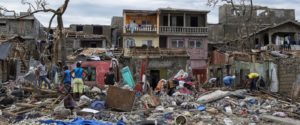Almost 900 residents died due to Hurricane Matthew which slammed Haiti.
The number of residents who died at the aftermath of Hurricane Matthew continues to soar in Haiti.
Based on the latest figures of the authorities, the number of dead soars to 877, while tens of thousands were left homeless due to massive destruction.
These information started to flow in slowly from remote areas that the communication were cut off by the storm. With these information, it became clear that at least 175 people died in villages clustered among the hills and on the coast of fertile western tip of Haiti.

Reports show that since the storm hit on Tuesday, rural clinics overflowed with patients whose wounds including broken bones had not been treated. Food was also scarce and at least seven people died of cholera because of flood water mixing with sewage.
Photos illustrate that the storm razed homes to their foundations. Many structures were turned into debris due to the effects of the hurricane. The corrugated metal roofs of those still standing were ripped off, the contents visible from above as if peering into doll’s houses, all things were wet.
Three towns have already reported dozens of fatalities. Included here is the hilly farming village of Chantal, whose mayor said 86 people were killed. Most of those who died were when trees crushed houses. Aside from those who died, the mayor said 20 more people were missing.
The central civil protection agency of Haiti takes longer to collate numbers because it needs to visually confirm victims itself. But according to them, 271 people died as Matthew smashed through the western peninsula on Tuesday bringing 145 mph (233 kph) winds and torrential rain.
The agency further said that some 61,500 people were in shelters as of this time.
Louis-Paul Raphael, the central government representative in the region, said coastal town Les Anglais lost “several dozen” people.
Les Anglais was the first place in Haiti that Matthew reached, as a powerful Category 4 storm before it moved north, lost strength and lashed central Florida on Friday.
In order to survive, locals have been helping each other because aid has been slow to reach towns and villages with cellphone networks down and roads flooded by sea and river water.
